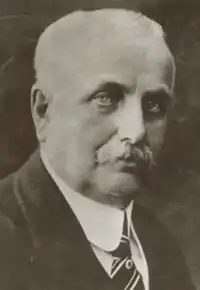| Year | Pop. | ±% p.a. |
|---|---|---|
| 1870 | 9,336 | — |
| 1880 | 10,697 | +1.37% |
| 1890 | 14,725 | +3.25% |
| 1900 | 21,696 | +3.95% |
| 1910 | 26,730 | +2.11% |
| 1920 | 31,285 | +1.59% |
| 1930 | 32,205 | +0.29% |
| 1940 | 33,385 | +0.36% |
| 1950 | 34,350 | +0.29% |
| 1960 | 33,306 | −0.31% |
| 1970 | 30,787 | −0.78% |
| 1980 | 27,861 | −0.99% |
| 1990 | 29,429 | +0.55% |
| 2000 | 26,705 | −0.97% |
| 2010 | 27,023 | +0.12% |
| 2020 | 24,685 | −0.90% |
| U.S. Decennial Census[1] | ||
The history of Watertown, a city in Jefferson County, New York, can be traced to the purchase of Upstate New York by Alexander Macomb, leading to a settlement east of Lake Ontario in the early 19th century. The area had seen human occupation since at least the second glacial period, but significant change into what is now known as Watertown did not occur until the beginning of the Machine Age. The city, which was incorporated in 1869, had expanded primarily through trade with Canada. The city destroyed many factories and historical buildings in the 1960s, which began a steady decline in population, from 33,306 in 1960 to 24,685 in 2020, a loss of 26%.
Prehistory
- c.12,000 BP: Ice from the pleistocene period recedes, leaving the area underwater for ≈ 1,000 years.[2]
- c.11,000 BP: Land emerges from underwater.[2]
- Glacial Period: Native Americans follow Caribou into the area and settle.[2]
18th century
- 1791: Area bought by Alexander Macomb.[2]
- 1796: Area scouted by Benjamin Wright.[2][3]
19th century
- March 1800: Houses first built by Pioneers.[3][4]
- 1801: A Church is built.[4]
- 1802
- School Built.[4]
- Hydropower using the fast moving water of the Black River begins.[4]
- 1804: The Postal Station is built.[4]
- 1805: The Public Square is allowed to be used by the public.[2][4]
- 1816
- Watertown Incorporated as a Village.[4][5]
- First Bank opened.[4]
- Local Fire Department begins.[4]
- 1842: Rome, Watertown and Ogdensburg Railroad built.[6]
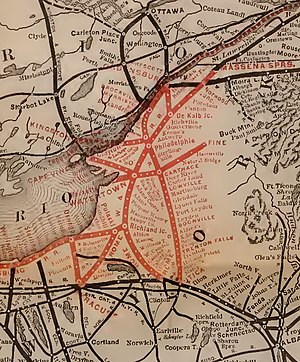 The Rome, Watertown and Ogdensburg Railroad path, 1889.
The Rome, Watertown and Ogdensburg Railroad path, 1889. - 1847: First Portable steam engine to be made in the United States made in Watertown.[2][4]
- 1849
- Safety pin is invented by Walter Hunt of Watertown.[2][4]
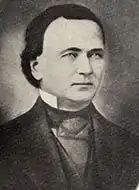 Walter Hunt. He invented the Safety pin and the first lockstitch sewing machine in 1832.
Walter Hunt. He invented the Safety pin and the first lockstitch sewing machine in 1832. - A fire destroys most of the Public Square and surrounding buildings.[7][2]
- Safety pin is invented by Walter Hunt of Watertown.[2][4]
- 1850: Paddock Arcade built.[8]
- 1853: Public water system and illuminating gas works installed.[4]
- 1861: Watertown Daily Times begins.[9]
- 1862: Jefferson County Courthouse Complex built.[10]
- 1869
- 1878: FW Woolworth comes up with the 5 and dime store in Watertown.[4]
- 1879: Public Telephones installed.[4]
- 1881: Samaritan Medical Center opens in Watertown.[11]
- 1884: Electric lighting system established.[4]
- 1889
- 1891: Soldiers and Sailors Monument built.[14]
- 1894: Public Square paved.
 The Public Square 4 years after it was paved in 1898.
The Public Square 4 years after it was paved in 1898.
20th century
- July 11, 1903: Roswell P. Flower Memorial Library begins construction.[15]
- 1904: Emerson Place built.[16]
- November 10, 1904: Roswell P. Flower Memorial Library completed.[15]
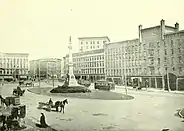 The Public Square in 1905.
The Public Square in 1905. - 1909: Thomas Memorial AME Zion Church built.[17]
- 1912: Parish House built.[13]
- 1914: Watertown Masonic Temple built.[18]
- 1916: Thompson Park officially gifted to Watertown by John C. Thompson.[4]
- 1920: City manager government style begins.[19]
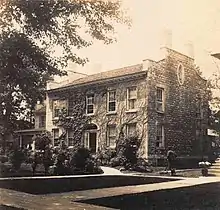 The Orville Hungerford Home in c. 1920
The Orville Hungerford Home in c. 1920 - 1925: Golf course built.[4]
- 1926: Interurban bus lines spanning 800 miles built.[4]
- 1927
- 1952: Little Trees invented by Watertown resident Julius Sämann.[4][21]
- May 1960: The Fountain in the Public Square is built and dedicated.[22]
- 1970: Construction on the Dulles State Office Building begins.[23]
- 1972: Construction on the Dulles State Office Building finished.[23]
21st century
References
- ↑ "Census of Population and Housing". Census.gov. Archived from the original on April 26, 2015. Retrieved June 4, 2015.
- 1 2 3 4 5 6 7 8 9 10 WPBS-TV (September 22, 2017), Discovering Watertown, retrieved February 24, 2022
- 1 2 Skinner 1876, pp. 12–13.
- 1 2 3 4 5 6 7 8 9 10 11 12 13 14 15 16 17 18 19 20 21 22 "City of Watertown, New York - Watertown History". www.watertown-ny.gov. Retrieved February 9, 2022.
- 1 2 Chisholm, Hugh, ed. (1911). . Encyclopædia Britannica. Vol. 28 (11th ed.). Cambridge University Press. p. 411.
- ↑ "Convertible mortgage bond of Rome, Watertown and Ogdensburgh Railroad Company which operated in the years 1842–1891 (officially until 1913)". Muzeum Uniwersytetu Warszawskiego. January 3, 2022. Retrieved February 24, 2022.
- ↑ "Hamilton Child's Jefferson County Gazetteer 1890". Child's Gazetteer. Rootsweb. Archived from the original on October 20, 2015. Retrieved July 4, 2008.
- ↑ Semento, Kristen. "The Paddock Arcade - The Oldest Continually-operated Mall in America". UpstateHistorical. Retrieved February 24, 2022.
- ↑ "About Us". NNY360. Retrieved February 24, 2022.
- ↑ "NPGallery Asset Detail". npgallery.nps.gov. Retrieved February 24, 2022.
- ↑ "About Samaritan Health". Samaritan Health. Retrieved February 9, 2022.
- ↑ "NPGallery Asset Detail". npgallery.nps.gov. Retrieved February 24, 2022.
- 1 2 "NPGallery Asset Detail". npgallery.nps.gov. Retrieved February 24, 2022.
- ↑ "Soldiers & Sailors Monument - EverGreene". evergreene.com. Retrieved February 24, 2022.
- 1 2 Flower Memorial Library Tour Brochure (PDF). p. 1. Archived (PDF) from the original on January 28, 2022. Retrieved February 9, 2022.
- ↑ "NPGallery Asset Detail". npgallery.nps.gov. Retrieved February 24, 2022.
- ↑ "02000144". npgallery.nps.gov. Retrieved February 9, 2022.
- ↑ "NPGallery Asset Detail". npgallery.nps.gov. Retrieved February 24, 2022.
- ↑ "City Manager Job in Watertown, New York at ICMA | JobSearcher". jobsearcher.com. Retrieved February 24, 2022.
- ↑ FOX, CRAIG. "Major repairs shut down Watertown hydroelectric plant". NNY360. Retrieved February 9, 2022.
- ↑ Greenbaum, Hilary; Rubinstein, Dana (March 2, 2012). "Who Made Those Little Trees Air Fresheners?". The New York Times Magazine.
- ↑ "Public Square Fountain Historical Marker". www.hmdb.org. Retrieved February 17, 2022.
- 1 2 "Dulles State Office Building". Emporis. Archived from the original on March 2, 2021. Retrieved February 24, 2022.
- 1 2 "Watertown, NY Official Site Streetscape Project". Downtown Watertown. City of Watertown, NY. Archived from the original on November 29, 2010. Retrieved July 4, 2008.
Citations
- Skinner, Charles Rufus (1876). Watertown, N.Y. : a history of its settlement and progress, with a description of its commercial advantages : as a manufacturing point, its location, its unsurpassed water power, its industries and general features of attraction to capitalists and manufacturers. Watertown, N.Y.: Watertown Manufacturers Aid Association.
External links
This article is issued from Wikipedia. The text is licensed under Creative Commons - Attribution - Sharealike. Additional terms may apply for the media files.
